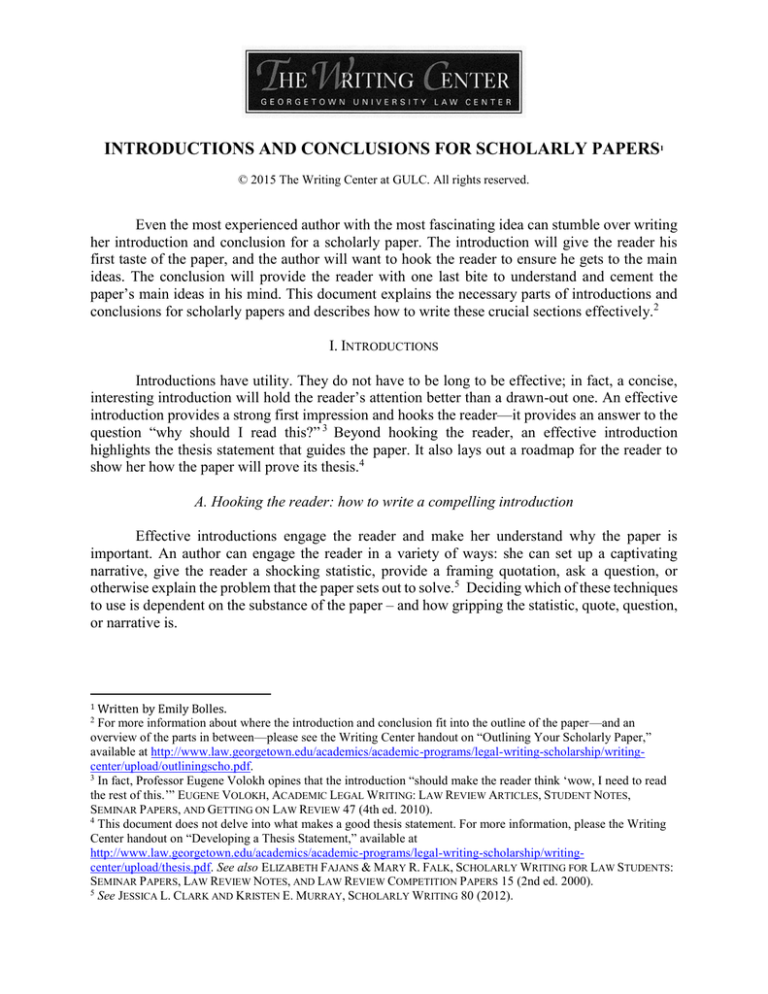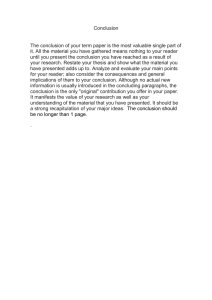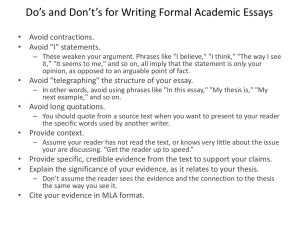
INTRODUCTIONS AND CONCLUSIONS FOR SCHOLARLY PAPERS1
© 2015 The Writing Center at GULC. All rights reserved.
Even the most experienced author with the most fascinating idea can stumble over writing
her introduction and conclusion for a scholarly paper. The introduction will give the reader his
first taste of the paper, and the author will want to hook the reader to ensure he gets to the main
ideas. The conclusion will provide the reader with one last bite to understand and cement the
paper’s main ideas in his mind. This document explains the necessary parts of introductions and
conclusions for scholarly papers and describes how to write these crucial sections effectively.2
I. INTRODUCTIONS
Introductions have utility. They do not have to be long to be effective; in fact, a concise,
interesting introduction will hold the reader’s attention better than a drawn-out one. An effective
introduction provides a strong first impression and hooks the reader—it provides an answer to the
question “why should I read this?” 3 Beyond hooking the reader, an effective introduction
highlights the thesis statement that guides the paper. It also lays out a roadmap for the reader to
show her how the paper will prove its thesis.4
A. Hooking the reader: how to write a compelling introduction
Effective introductions engage the reader and make her understand why the paper is
important. An author can engage the reader in a variety of ways: she can set up a captivating
narrative, give the reader a shocking statistic, provide a framing quotation, ask a question, or
otherwise explain the problem that the paper sets out to solve.5 Deciding which of these techniques
to use is dependent on the substance of the paper – and how gripping the statistic, quote, question,
or narrative is.
Written by Emily Bolles.
For more information about where the introduction and conclusion fit into the outline of the paper—and an
overview of the parts in between—please see the Writing Center handout on “Outlining Your Scholarly Paper,”
available at http://www.law.georgetown.edu/academics/academic-programs/legal-writing-scholarship/writingcenter/upload/outliningscho.pdf.
3
In fact, Professor Eugene Volokh opines that the introduction “should make the reader think ‘wow, I need to read
the rest of this.’” EUGENE VOLOKH, ACADEMIC LEGAL WRITING: LAW REVIEW ARTICLES, STUDENT NOTES,
SEMINAR PAPERS, AND GETTING ON LAW REVIEW 47 (4th ed. 2010).
4
This document does not delve into what makes a good thesis statement. For more information, please the Writing
Center handout on “Developing a Thesis Statement,” available at
http://www.law.georgetown.edu/academics/academic-programs/legal-writing-scholarship/writingcenter/upload/thesis.pdf. See also ELIZABETH FAJANS & MARY R. FALK, SCHOLARLY WRITING FOR LAW STUDENTS:
SEMINAR PAPERS, LAW REVIEW NOTES, AND LAW REVIEW COMPETITION PAPERS 15 (2nd ed. 2000).
5
See JESSICA L. CLARK AND KRISTEN E. MURRAY, SCHOLARLY WRITING 80 (2012).
1
2
For example, let’s pretend you are writing a paper condemning the Supreme Court’s
decision in Citizens United. Here are a few options for your introduction:
“A corporation is an artificial being, invisible, intangible, and existing only in
contemplation of law . . . it possesses only those properties which the charter of its creation
confers upon it, either expressly or as incidental to its very existence.” This is John
Marshall’s definition of a corporation in Dartmouth College v. Woodward.6
Seventy-eight percent of 2012 outside election spending can be attributed to the 2010
Citizens United ruling.7
What do you think of when you hear the word “person”? Some say “human” and evoke
qualities like free will and rational thinking. Others think of breath—or a heartbeat.
Citizens United was decided on January 21st, 2010.
Just based on these sentences, which paper would you like to read? Chances are, it’s not the last
one—the date Citizens United was decided is not particularly interesting. Avoid factual recitation;
instead, an introduction should be creative and motivate the reader to keep going. Choosing
between the rest of these potential lead-ins is likely dependent on your thesis and what you want
to accentuate at the beginning of your paper.
You may also want to consider using a narrative introduction for your Citizens United
paper. Narrative introductions are common in scholarly writing, and can be incredibly effective.
A narrative introduction tells a short story for the reader that illustrates the problem the paper sets
out to solve. Effective narrative introductions are above all vivid.8 You might open your Citizens
United paper with a story about a headline-grabbing attack-ad crossfire between Mitt Romney and
Newt Gingrich, 9 a portrayal of the current state of presidential elections, 10 or a narrative
description of a hypothetical,11 or any other compelling narrative you find in your research.
B. Connecting to the thesis statement
An effective introduction highlights and gives depth to the thesis statement. Practically,
that means that the introduction must set the stage for the thesis statement to make sense to the
reader and that the introduction must state the thesis!12
Trustees of Dartmouth Coll. v. Woodward, 17 U.S. 518, 636 (1819). For examples of law review articles that open
with a quote, see Colin Cox, Protecting Free Speech After Citizens United: Why Overruling Austin v. Michigan
Chamber of Commerce Violates the First Amendment and Encourages Corruption in Campaigns, 55 S. TEX. L. REV.
339 (2013); Molly J. Walker Wilson, Too Much of A Good Thing: Campaign Speech After Citizens United, 31
CARDOZO L. REV. 2365 (2010).
7
78% of Outside Campaign Spending Due to ‘Citizens United Effect’, COMMON DREAMS,
http://www.commondreams.org/news/2012/09/24/78-outside-campaign-spending-due-citizens-united-effect (last
visited Feb. 1, 2015).
8
See VOLOKH, supra note 3, at 52.
9
See Leslie A. Gordon, Citizens Dis-United Justices May Take Another Look at Controversial Campaign Finance
Case, ABA J., May 2012, at 20.
10
James A. Kahl, Citizens United, Super Pacs, and Corporate Spending on Political Campaigns: How Did We Get
Here and Where Are We Going?, FED. LAW., June 2012, at 40.
11 Citizens United at Work: How the Landmark Decision Legalized Political Coercion in the Workplace, 128 HARV.
L. REV. 669 (2014).
12
CLARK & MURRAY, supra note 2.
6
2
Let’s pretend that the thesis statement of your paper is “Under an original intent reading of
the Constitution, the Citizens United decision should be overturned because it went against our
founding principles and was blatant judicial overreach.” The John Marshall quote listed above may
serve your paper well as an introduction because it harkens back to earlier meanings of the word
“corporation” and thus implicates originalism. Conversely, the seventy-eight percent statistic
would not be an effective introduction because it is not tied to your thesis—even though it is related
to Citizens United, the topic of your paper.
C. Roadmapping the paper
Finally, an effective introduction will include a roadmap for the paper. Roadmaps preview
the large scale organization for your reader and lay out how your analysis will proceed. Generally,
the roadmap is the last paragraph in your introduction. The roadmap should lay out all the parts of
your paper, but remember: the idea is that your reader will be able to expect and understand your
large-scale organization. Though effective roadmap paragraphs in different papers may differ in
their length and complexity, all effective roadmaps accurately represent the organization of the
paper and clearly tell the reader what that organization is.
Let’s say your Citizens United paper is split into four parts, with these headings: I.
Introduction; II. Original Intent and the Failings of Judicial Activism; III. Corporate Definition:
Case Law Before Citizens United; IV. Getting it Wrong: Citizens United as Judicial Activism; V.
Conclusion.
Given those headings, a hypothetical roadmap for your Citizens United paper may look
like this:
Part II discusses original intent as a Constitutional theory and explains the
failings of judicial activism in creating coherent jurisprudence. Part III describes
case law leading up to Citizens United, showing that “personhood” did not include
corporations in the early years of the American government. Part IV applies a
theory of original intent to Citizens United and argues that the case was wrongly
decided and should be overturned.
Through this roadmap, your reader will understand how your paper is organized, and the
organization will make logical sense to the reader because it revolves around the background
information and new analysis that is necessary to support your conclusion.
Recap: Introductions
Is the entire introduction concise and short enough to hold the reader’s attention?
Are the first few sentences interesting?
Does the introduction provide context for the thesis statement?
Does the introduction clearly state the thesis?
Does the introduction provide a roadmap paragraph?
Does the roadmap paragraph accurately reflect the large scale organization of the paper?
3
II. CONCLUSIONS
Though they sometimes get short shrift in legal writing texts,13 conclusions are a crucial
part of any scholarly paper. Conclusions wrap up the paper and are the last opportunity for the
author to make an impression on the reader. Effective conclusions reiterate the problem the thesis
set out to solve, remind the reader what the thesis of the paper is and why it’s correct, and—best
of all—are short and to the point. 14
To reiterate the problem that motivates the paper, it is effective to harken back to the
introduction. Invoking the introduction in the conclusion has the added benefit of tying the paper
together nicely and providing the reader with a sense of closure. For example, in your Citizens
United paper, if you started off with a John Marshall quote, your conclusion might start with the
sentences: “The Framers and respected judges in the early years of the American government never
would have granted corporations personhood. Instead, as indicated by John Marshall, the founding
generation considered corporations as artificial legal constructs without rights other than those
vital to their existence.”
Effective conclusions also remind the reader of your thesis and show her why your thesis
is right. The conclusion can loosely follow the organization of your paper to parallel your roadmap
given in the introduction, but the focus should be on the paper’s analysis rather than on the
organization. For example, your Citizens United paper would likely condemn judicial activism,
reiterate the holding of Citizens United in your words, and remind the reader that you think the
case should be overturned. Importantly, effective conclusions do not bring in new information or
analysis; instead, they sum up what is already contained in the paper.
13
14
See VOLOKH, supra note 3, at 76–78.
CLARK & MURRAY, supra note 2, at 86–87.
4
When putting together your conclusion, remember: effective conclusions are respectful of
the reader’s time and do not drag on. They are often only one to two paragraphs.15
Recap: Conclusions
Does the conclusion remind the reader of the problem the paper sets out to solve?
Does the conclusion incorporate aspects of the introduction to give the reader closure?
Does the conclusion’s organization parallel the paper’s organization?
Does the conclusion re-state the thesis?
Is the conclusion short (one to two paragraphs)?
15
See, e.g., Citizens United at Work: How the Landmark Decision Legalized Political Coercion in the Workplace,
128 HARV. L. REV. 669, 690 (2014); Daniel Winik, Citizens Informed: Broader Disclosure and Disclaimer for
Corporate Electoral Advocacy in the Wake of Citizens United, 120 YALE L.J. 622, 666 (2010); Sean McMahon,
Deregulate but Still Disclose?: Disclosure Requirements for Ballot Question Advocacy After Citizens United v. FEC
and Doe v. Reed, 113 COLUM. L. REV. 733, 775 (2013).
5



